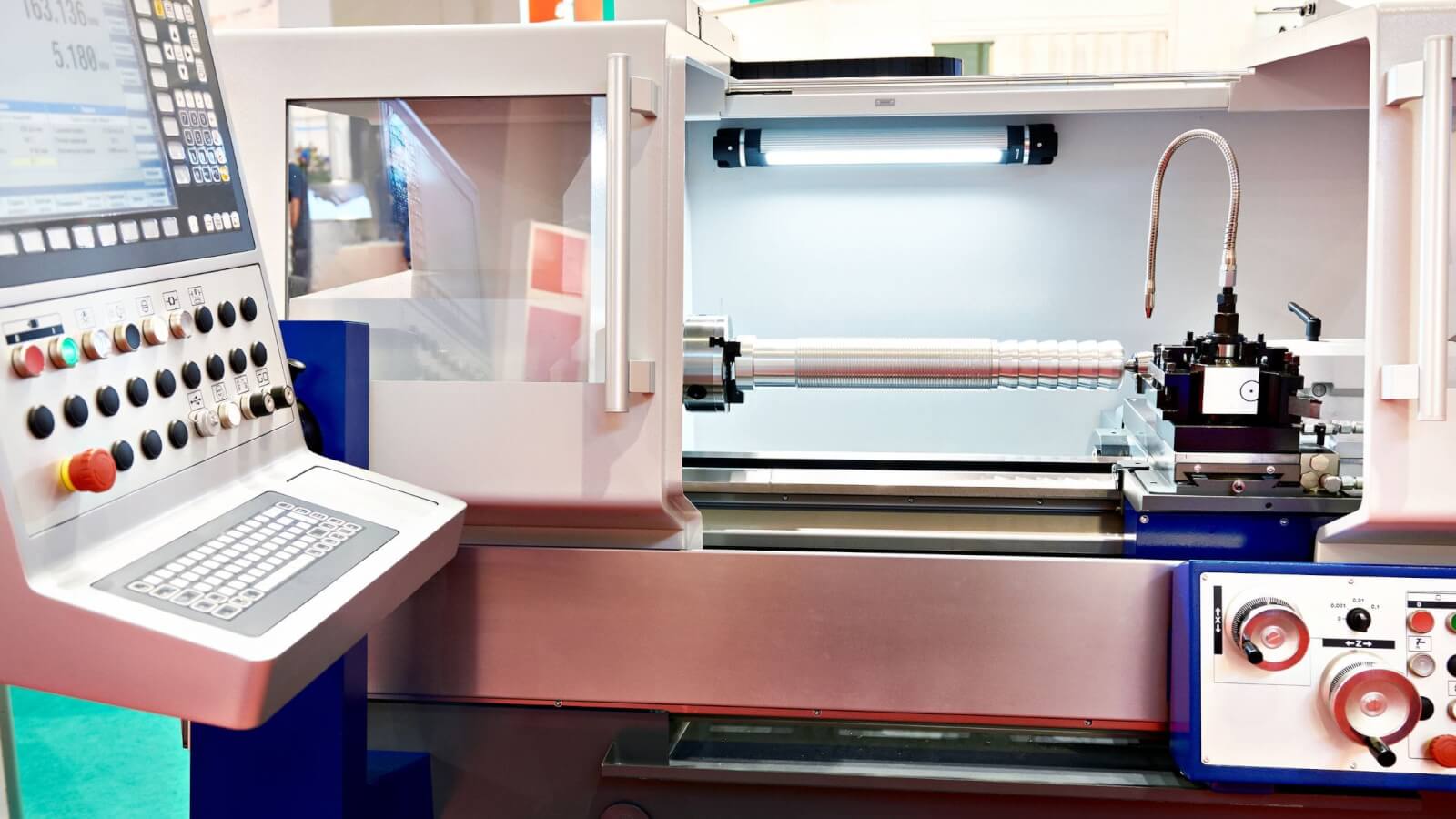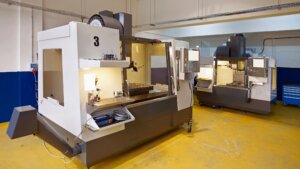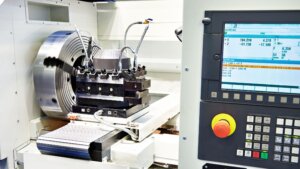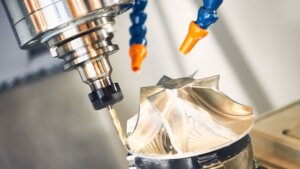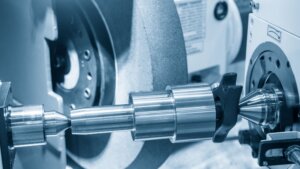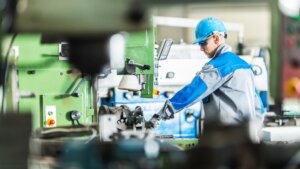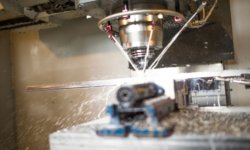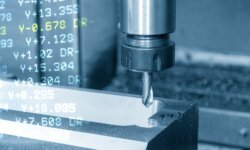The world of modern machining is a realm where precision meets innovation, and at the heart of this technological marvel lies the CNC Lathe – a cornerstone in advanced manufacturing. This article delves deep into the essence of CNC lathes, exploring their history, functionality, types, and much more, unraveling the complexities of these sophisticated machines.
What is а CNC Lathe?
A CNC lathe is a sophisticated machine tool designed for precision CNC turning and manufacturing through Computer Numerical Control (CNC).
It’s an embodiment of technological evolution, marrying the age-old principles of a lathe machine with advanced computer programming to achieve unprecedented accuracy and efficiency in machining.
The CNC lathe machine tool has revolutionized how materials are manipulated, making it an indispensable tool in various industries and many machine shops. Its ability to perform intricate cutting and shaping with incredible precision makes it a cornerstone in modern manufacturing processes. Whether it’s metal, plastic, or wood, the CNC lathe’s versatility in handling diverse materials is unmatched.
Short history of CNC Lathe
Embarking on a journey back in time, the history of the CNC lathe is a fascinating tale of technological evolution. The inception of the CNC lathe marks a significant milestone in the transition from manual to automated machining.
When was CNC lathe invented?
The genesis of the CNC lathe dates back to the 1940s and 1950s. This era witnessed the birth of a new technological wave, driven by the need for more precise and efficient manufacturing methods.
The advent of computer technology was the catalyst that transformed traditional lathes into the highly sophisticated CNC lathes we know today.
Pioneers like John T. Parsons and Frank L. Stulen were instrumental in this transformation, with their work in the aviation industry leading to the development of the first numerically controlled machines. These early versions laid the groundwork for the CNC lathes that have become integral in modern manufacturing.
How Does a CNC Lathe Machine Work?
Delving into the workings of a CNC lathe unveils a symphony of precision engineering and computerized control. Unlike a manual lathe, where the craftsmanship lies primarily in the hands of the operator, a CNC lathe integrates computerized technology to enhance precision and efficiency. Here’s a detailed look at its process:
- Design Phase: Initially, you, the operator, create a detailed design using CAD (Computer-Aided Design) software. This design includes all specifications for the desired part, from dimensions to shapes.
- Programming: The CAD design is then translated into G-code, the programming language that CNC machines understand. This code instructs the CNC lathe on how to move, shape, and create the part.
- Setup: Next, you set up the CNC lathe. This involves selecting and installing the appropriate cutting tools and securing the workpiece onto the machine.
- Machining Process: The CNC lathe, guided by the G-code, begins the machining process. The workpiece is rotated at high speeds while the cutting tool is moved across two or more axes to shape the material.
- Quality Check: Throughout the process, the CNC lathe monitors the cutting conditions and makes real-time adjustments to ensure precision. The final part is checked against the original specifications for accuracy.
What are the Key Components of a CNC Lathe Machine?
A CNC lathe is an assembly of intricate components, each playing a crucial role in its operation. Understanding these components gives you a deeper insight into how these machines achieve such high levels of precision and efficiency. Here’s a breakdown of the key parts:
- Main Spindle: The heart of the lathe, where the workpiece is mounted and rotated.
- Chuck: A device that holds the workpiece in place on the spindle.
- Tailstock: Provides additional support for longer workpieces, ensuring stability during machining.
- Tool Turret: Holds various cutting tools and rotates to bring the desired tool into position.
- Control Panel (CNC Controller): The interface where you input the G-code and control the machine’s operations.
- Bed: The base that supports all major components of the lathe.
- Carriage: Moves along the bed, carrying the cutting tool and guiding it along the workpiece.
- Headstock: Houses the main spindle and often includes the gear mechanism for controlling spindle speed.
- Coolant System: Delivers coolant to the cutting area to manage temperature and prolong tool life.
- Chip Conveyor: Removes the metal chips produced during machining, keeping the work area clean.
What Types of CNC Lathes Are Available?
The world of CNC lathes is diverse, with each type tailored to specific machining needs. Understanding the different types available is key to choosing the right one for your projects. Let’s explore the most common types:
2-Axis CNC Lathe
A 2-Axis CNC Lathe is the fundamental model in CNC machining. It operates on two linear axes, X and Z. The X-axis controls the diameter, moving the tool inwards and outwards, while the Z-axis controls the length, moving the tool back and forth along the workpiece. This setup is ideal for simple and symmetrical parts.
Applications and Use Cases:
- Turning Operations: Ideal for creating cylindrical parts.
- Facing Tasks: Efficient for creating flat surfaces on the ends of workpieces.
- Drilling and Boring: Capable of drilling holes and enlarging them to precise dimensions.
- Grooving and Parting: Suitable for making grooves and separating parts from the workpiece.
Preferred Projects:
- Symmetrical Components: Best for parts with uniform shapes like rods and shafts.
- General Manufacturing: Commonly used in mass production due to its efficiency and simplicity.
3-Axis CNC Lathes
The 3-Axis CNC Lathe introduces an additional Y-axis, expanding its capabilities beyond the 2-axis model. The Y-axis moves perpendicular to the X-Z plane, allowing for off-center milling operations. This added versatility makes it suitable for more complex shapes and designs.
Applications and Use Cases:
- Complex Turning: Able to handle more intricate designs than the 2-axis lathe.
- Off-Center Drilling and Milling: Can perform operations that are not aligned along the main axes.
- Advanced Shaping: Suitable for parts with non-cylindrical profiles.
- Multi-Process Machining: Combines turning with milling and drilling in a single setup.
Preferred Projects:
- Complex Geometries: Ideal for parts with irregular shapes and features.
- Precision Components: Offers higher precision for critical applications in industries like aerospace and medical.
- Custom Manufacturing: Perfect for bespoke or limited-edition productions where complexity and precision are paramount.
4-Axis CNC Lathes
A 4-Axis CNC Lathe introduces an additional axis, usually the C-axis, which allows the spindle to rotate perpendicularly to the cutting plane. This added axis expands the machine’s ability to create complex shapes and patterns, offering you more versatility in CNC lathe machining.
Applications and Use Cases:
- Complex Contours: Ideal for creating intricate designs that require both turning and milling.
- Precision Engraving: Capable of detailed engraving work on cylindrical surfaces.
- Off-Center Drilling and Milling: Enhances the ability to perform operations away from the centerline of the workpiece.
- Multi-Process Machining: Streamlines the production process by combining different operations in one setup.
Preferred Projects:
- Advanced Aerospace Components: Well-suited for parts with complex geometries.
- Automotive Parts: Ideal for producing sophisticated components with intricate details.
- Custom Manufacturing: Optimal for projects requiring high precision and complex detailing.
5-Axis CNC Lathes
A 5-Axis CNC Lathe adds even more flexibility, with the additional axes (usually the A and B axes) enabling the tool to approach the workpiece from virtually any direction. This functionality is paramount for parts requiring complex geometries and angles.
Applications and Use Cases:
- Complex 3D Shapes: Perfect for machining parts with non-standard shapes.
- Simultaneous Cutting: Allows simultaneous movement along multiple axes, reducing machining time and improving precision.
- High-Precision Manufacturing: Offers unparalleled accuracy for critical components.
- Intricate Medical Devices: Ideal for producing small, complex parts used in medical equipment.
Preferred Projects:
- Aerospace and Defense: Essential for manufacturing complex aerostructures and defense components.
- Medical Industry: Suitable for creating intricate medical implants and devices.
- Custom Prototyping: Excellent for prototypes requiring detailed and accurate representation of final products.
6 or More Axis CNC Lathes
CNC Lathe machines with 6 or more axes represent the pinnacle of machining flexibility and precision. These lathes can manipulate the workpiece and the tool in multiple directions simultaneously, offering unparalleled capability in creating highly complex parts.
Applications and Use Cases:
- Ultra-Precise Components: Ideal for parts where tolerances are extremely tight.
- Complex Tool Paths: Capable of executing sophisticated tool paths that lesser axes machines cannot achieve.
- Multi-Faceted Manufacturing: Suitable for parts requiring a combination of turning, milling, drilling, and engraving in a single setup.
Preferred Projects:
- Advanced Engineering Applications: Essential in sectors that require extreme precision, such as aerospace engineering and precision engineering.
- Complex Industrial Components: Ideal for producing parts with complicated geometries that are used in advanced machinery.
- Research and Development: Perfect for experimental designs where flexibility and precision are crucial.
What is the difference between a horizontal and a vertical CNC lathe?
The primary distinction between horizontal and vertical CNC lathes lies in their orientation and the applications they’re best suited for.
Horizontal CNC Lathes:
- Orientation: The spindle in a horizontal lathe is positioned horizontally, with the workpiece mounted perpendicularly to the axis.
- Applications: Primarily used for longer, cylindrical workpieces.
- Advantages: Easier chip evacuation due to gravity, generally better for heavier and larger workpieces.
- Limitations: May not be suitable for parts with complex geometries.
Vertical CNC Lathes:
- Orientation: The spindle is positioned vertically, with the workpiece attached to a horizontal chuck.
- Applications: Ideal for heavy, large-diameter, and short workpieces.
- Advantages: Gravity helps to secure the workpiece, reducing the need for extensive clamping. Offers better access to the workpiece for certain operations.
- Limitations: Not as effective for long, slender parts where gravity can impact accuracy.
3ERP CNC lathe machines
As a leading provider of CNC turning services, 3ERP has three high-quality CNC lathes in our factory from renowned manufacturers like Haas, Bochi and GM. They are capable of machining both plastic and metals, achieving tolerances as tight as 0.01mm (0.000393 inches) and
What Operations Can Be Performed on a CNC Lathe?
CNC lathes are versatile machines capable of performing a wide range of operations, each contributing to the creation of precise and intricate parts:
- Turning: The fundamental operation involving the removal of material from the exterior of a workpiece to produce cylindrical parts.
- Facing: Cutting a flat surface at the end of the workpiece or along its length.
- Drilling: Creating holes in the workpiece using a drill bit.
- Boring: Enlarging a hole previously drilled, achieving precise diameters and depths.
- Reaming: Finishing the drilled holes to improve their accuracy and surface finish.
- Threading: Cutting internal or external threads (such as screws or nuts) onto a workpiece.
- Knurling: Creating a regular, cross-patterned surface on the workpiece for better grip.
- Grooving: Cutting narrow grooves along the workpiece for functional or aesthetic purposes.
- Parting or Cutoff: Separating a part from the rest of the workpiece.
- CNC Milling: Incorporating milling operations in CNC lathes, especially those with additional axes, to create features off the main axis of the part.
- Chamfering: Cutting bevels at the edge of a workpiece.
- Eccentric Turning: Producing off-center or non-symmetrical shapes.
- Tapping: Forming internal threads using a tapping tool.
What Softwares are Used in CNC Lathe Programming and Machining?
The precision and efficiency of CNC lathes are largely due to the advanced software that drives them. This software spans from design to production, ensuring every aspect of the machining process is meticulously controlled and executed. Here’s an overview of the types of software used in CNC lathe programming and machining:
- CAD (Computer-Aided Design) Software: Vital for creating detailed designs and blueprints of the parts to be manufactured. Examples include AutoCAD, SolidWorks, and Fusion 360.
- CAM (Computer-Aided Manufacturing) Software: Transforms CAD designs into G-code, the language understood by CNC machines. Popular examples are Mastercam, Fusion 360, and GibbsCAM.
- CNC Simulation Software: Allows operators to simulate and visualize the entire machining process, aiding in error detection and prevention. VERICUT and Machining Simulation Software are notable examples.
- G-Code Editors: Provide the capability to write and edit G-code manually, ensuring greater control over the machining process. NC Corrector and G-Wizard Editor are widely used.
- Toolpath Generation Software: Essential for defining efficient paths for the cutting tools. Often integrated within CAM software packages.
- DNC (Distributed Numerical Control) Software: Facilitates seamless communication between computers and multiple CNC machines. Examples include Predator DNC and CIMCO DNC.
- Machine Monitoring and Management Software: Tracks the performance and efficiency of CNC machines, aiding in maintenance scheduling. MDC-Max and FactoryWiz are popular choices.
- Post-Processing Software: Converts CAM-generated toolpaths into machine-specific G-code, often a component of CAM packages.
- CAD/CAM Integrated Software: Combines the functionalities of CAD and CAM in a single package for streamlined workflow. Fusion 360 and BobCAD-CAM are examples of such integration.
- 3D Modeling Software: Used for creating complex 3D models that can be translated into machining operations. Rhino and Blender are suited for more artistic or intricate designs.
- Quality Control Software: Ensures the accuracy of machined parts by comparing them against the original CAD design. Hexagon PC-DMIS and Quality Control Systems are widely used for this purpose.
- Customizable Control Software: Offers personalized control interfaces or machine operations for advanced users. LinuxCNC and Mach3/Mach4 are examples of such software.
How Accurate is a CNC Lathe?
CNC lathes can achieve precision levels as tight as ±0.0005 inches (±0.0127 mm). This level of accuracy is essential in creating components for critical applications like aerospace, medical devices, and automotive manufacturing.
Along with precision, CNC lathes offer high repeatability, ensuring that every part produced matches the last with minimal variance. This consistency is crucial for large-scale production runs.
How Much Does CNC Lathe Cost?
The cost of CNC lathes varies widely based on type, size, functionality, and specific features. Here’s an average price range for different types of CNC lathes:
- Entry-Level CNC Lathes: These smaller and more basic machines are suitable for small businesses or hobbyists. They typically range from $20,000 to $60,000.
- Mid-Range CNC Lathes: Offering more features and capabilities, these machines are suited for medium-sized enterprises and more complex projects. Prices range from $60,000 to $250,000.
- High-End CNC Lathes: These lathes are equipped with advanced features like multiple axes, higher precision, and greater automation capabilities. This type of CNC machine is necessary for large-scale industrial manufacturing and can cost anywhere from $250,000 to over $500,000.
What is the Lifespan of a CNC Lathe?
CNC lathes typically have a lifespan of 10 to 15 years. However, with proper maintenance and care, many machines continue to operate efficiently well beyond this range.
What are the Best Practices for CNC Lathe Programming and Operation?
To harness a CNC turning machine full potential, it’s essential to follow best practices in programming and operation. Here’s a comprehensive guide, including software options, programming tips, and troubleshooting strategies:
- Understand Your Machine: Familiarize yourself with the specific CNC lathe machine you’re working with, including its capabilities and limitations.
- Choose the Right Software:
- CAD (Computer-Aided Design) for designing parts.
- CAM (Computer-Aided Manufacturing) for translating CAD designs into machine instructions (G-code).
- CNC Simulation Software for previewing and adjusting the machining process.
- Programming Methods:
- Direct Programming on the Machine: Utilize the CNC Programming Support System for on-the-spot programming, ideal for simpler tasks or modifications.
- Off-line Programming using CAD/CAM Systems: Best for complex operations, allowing detailed planning and simulation.
- Create Efficient Toolpaths: Optimize toolpaths for the shortest travel time while ensuring the quality of the cut.
- Tool Selection and Setup: Choose the appropriate tools for your operation, considering material, type of cut, and precision required.
- Material Consideration: Understand the properties of the material you are working with and adjust your programming accordingly.
- Test Runs and Simulations: Before the actual operation, run simulations or test programs to ensure everything works as planned.
- Regular Maintenance Checks: Keep your CNC lathe in top condition with regular maintenance, reducing the chances of errors and machine downtime.
- Stay Updated on Software: Regularly update your CAD/CAM and other software to leverage the latest features and security updates.
- Troubleshooting Common Issues: Develop a clear understanding of common machining issues and their solutions, like tool breakage, programming errors, or finish quality problems.
- Safety First: Always adhere to safety protocols, including proper machine guarding, use of personal protective equipment, and adherence to operational guidelines.
- Documentation and Records: Keep detailed records of your programming and machining operations, which can be invaluable for troubleshooting and future reference.
- Continuous Learning: Stay abreast of new technologies and techniques in CNC machining. Continuous learning is key to mastering CNC lathe programming and operation.
What is the Difference Between a CNC Lathe and a Regular Lathe?
Understanding the distinction between a CNC lathe and a regular lathe is crucial in choosing the right equipment for your machining needs. The main technological differences include:
- Control System: CNC lathes are controlled by a computer, whereas regular lathes are manually operated.
- Precision and Accuracy: CNC lathes offer significantly higher precision and consistency compared to regular lathes.
- Complexity of Operations: CNC lathes can perform complex operations and intricate designs, which are challenging to achieve with regular lathes.
- Production Speed and Efficiency: CNC lathes generally work faster and are more efficient, particularly for high-volume production.
- Skill Requirements: Operating a CNC lathe requires knowledge of programming and software, whereas manual lathes require traditional machining skills.
Conclusion
Its advanced technology, precision, and efficiency make a CNC lathe machine indispensable for a wide range of applications.
By understanding the nuances of CNC lathe operation, lifespan, and the differences from traditional lathes, businesses and operators can make informed decisions that maximize productivity and maintain quality.
FAQs
How Loud is a CNC Lathe?
CNC lathes vary in noise level depending on size and operation, but they generally produce around 70 to 90 decibels during operation, similar to the noise level of a hairdryer or a lawnmower.
What is the M Code of CNC Lathe?
M codes are part of the programming language for CNC machines, controlling the miscellaneous functions that do not involve the movement of the tool. Examples include M03 for spindle start and M05 for spindle stop.
How Much Electricity Does a CNC Lathe Use?
The electricity usage of a CNC lathe depends on its size and complexity. On average, smaller lathes may use about 5 to 10 kW, while larger industrial models can consume 20 kW or more during heavy operation.
